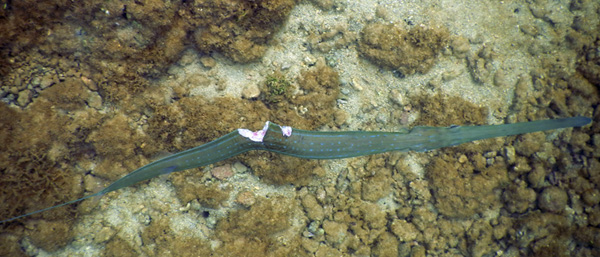Published in the Ocean Watch column, Honolulu Star-Advertiser © Susan Scott
June 30, 2014
While snorkeling last week, I came across a 3-foot-long bluespotted cornetfish bitten nearly in half. Amazingly, the severely injured fish was swimming along just fine. Six days later I went snorkeling in the same area and couldn’t believe my eyes. There was the same wounded cornetfish, slower now but still swimming.
That fish had such gumption I wished I could take it to an emergency room and have it sewn up. But as there are no fish hospitals that I know of, I’ll salute that fish by writing about its kind.
One unusual feature of the cornetfish family (four species, two in Hawaii) is that the body is wider across the back than it is deep, meaning from back to belly.
 A cornetfish suffered a severe cut but kept swimming.
A cornetfish suffered a severe cut but kept swimming.
©2014 Susan Scott
In the bluespotted cornetfish, Hawaii’s most common, snorkelers from above see a long, blue-spotted and blue-lined back several inches wide. In front of the body stretches a long, narrow snout and behind trails a long, streaming tail. (The key word for this fish is “long.”) The tail filament has sensory pores, but no one knows what they sense.
If you alarm a cornetfish, or if it’s stalking prey, the blue spots and lines covering the back turn to dark bars in a kind of plaid pattern that blends well against a pebbly reef floor.
When viewed from the side, cornetfish look like a silver slat, something similar to a side view of an aluminum yardstick. Make that nearly two yardsticks. Including the tail streamer, bluespotted cornetfish grow to over 5 feet long.
Both top-down and side-on camouflage comes in handy for an ambush. The cornetfish can drift toward a fish or shrimp undetected and, with lightning speed, suck the meal into its expandable mouth.
When doing so, the mouth opening flares, resembling the end of a cornet. The brass-horn name also comes from a gooselike honk the fish makes if startled at night.
On Day 7 I couldn’t find my maimed cornetfish and felt relief. I know, of course, that the ocean is one huge fish-eat-fish world, but even so, it’s hard to watch an animal die a long, painful death.
My guess is that a barracuda, common in my snorkeling area, bit the large cornetfish’s back. That the fish escaped and went on to live for a week is a tribute to a remarkable species.